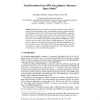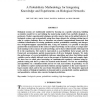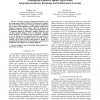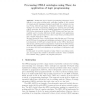252 search results - page 6 / 51 » Using OWL to model biological knowledge |
ASWC
2006
Springer
13 years 11 months ago
2006
Springer
Abstract. Semantics shows diversity in real world, document world, mental abstraction world and machine world. Transformation between semantics pursues the uniformity in the divers...
SEMWEB
2007
Springer
14 years 1 months ago
2007
Springer
Abstract. Design patterns are widely-used software engineering abstractions which define guidelines for modeling common application scenarios. Ontology design patterns are the ext...
JCB
2006
13 years 7 months ago
2006
Biological systems are traditionally studied by focusing on a specific subsystem, building an intuitive model for it, and refining the model using results from carefully designed ...
IAT
2010
IEEE
13 years 5 months ago
2010
IEEE
Abstract--The paper proposes a biologically-inspired cognitive agent model, known as FALCON-X, based on an integration of the Adaptive Control of Thought (ACT-R) architecture and a...
SEMWEB
2009
Springer
14 years 2 months ago
2009
Springer
Traditional object-oriented programming languages can be difficult to use when working with ontologies, leading to the creation of domain-specific languages designed specifically...




